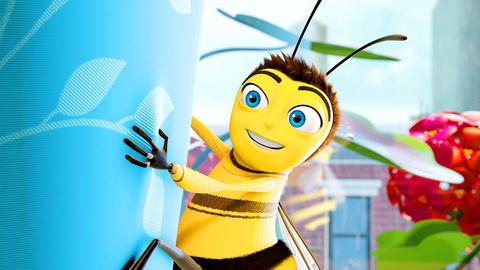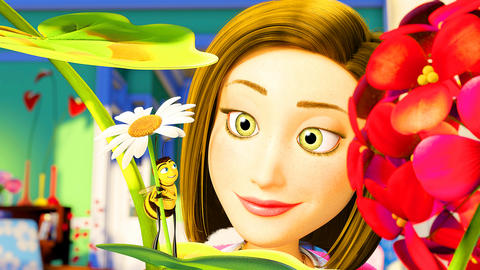Bees rarely fly in a straight line. They hover and zigzag, with a purpose known only to the collective brain of the hive. The most genuinely apian aspect of Bee Movie, DreamWorks' new animated movie about, well, bees, is that it spends a lot of its short running time buzzing happily around, sniffing out fresh jokes wherever they may bloom. There is a plot - the usual big, elaborate story with the usual important messages about saving the planet, living together in interspecies harmony and believing in yourself - but it's a little beside the point. The real fun is the insect shtick.
The DreamWorks Animation formula, exemplified in the mighty Shrek franchise (and imitated by would-be rivals at Sony and Fox), is to charm the children with cute creatures and slapstick action while jabbing at the grown-ups with soft, pseudosophisticated pop-cultural satire. Bee Movie, directed by Simon Smith and Steve Hickner and animated by several hundred industrious drones, pushes this strategy almost to the point of dispensing with the kid stuff altogether.
There are a few splendid cartoon set pieces - including a funny, thrilling bee's-eye tour of New York, from Central Park flora to the surface of a tennis ball to the inside of a speeding car - that show off the latest computer animation techniques. But most of the film's creative energy is verbal rather than visual, and semimature rather than strictly juvenile.

PHOTO: COURTESY OF UIP
Which is hardly surprising. As everyone knows by now, the leading man (and one of the screenwriters and producers) is Jerry Seinfeld, whose sitcom, almost a decade off the network air, lives on in syndication and in the endless recycling of memorable one-liners by a certain type of pathetic Gen-Xer. (Not me, though. I'm the complete opposite of every film critic you've ever met. I'm the master of my domain.)
Seinfeld provides the voice and attitude for Barry B. Benson, a young bee who has reached the stage in his accelerated bug lifestyle when he must choose a career. The hive where he lives is a highly regimented place, where the bees, conditioned by 27 million years of evolution, work without a break in the same job for their whole lives. Visually, this world resembles a sweet, sunny, corporate version of Fritz Lang's Metropolis.
Barry's nerdy pal, Adam (Matthew Broderick), accepts his drone future as part of the natural order of things, but Barry is a maverick, an individualist yearning to break out of the conformist world of the social insects.

PHOTO: COURTESY OF UIP
He may also remind some viewers of Benjamin Braddock, the alliteratively named hero of The Graduate, a film that Bee Movie cites in a few amusing scenes. Not that Barry has an affair with a middle-aged mama bee (all bees are children of the queen, a biological fact the film notes only in passing). Instead he flies even farther from the nest, so to speak, falling in love with an actual human being, a Manhattan florist named Vanessa who speaks in the irresistibly sweet voice of Rene Zellweger.
When you stop to think about it, the prospect of romance between a bee and a person raises some potentially awkward, not to say physiologically outlandish, questions. But of course you're not supposed to think about it. The moral of the story - one of them, anyway - is that we and the bees are interdependent and that we should respect their hard work.
This lesson is satirically driven home in a courtroom plot that erupts just as the love story starts to get sticky. When Barry discovers that honey is sold in supermarkets, and that it is harvested from captive bees held in smoky, shoddy fake hives, he sues the human race, going after some of its notorious bee abusers. These include Ray Liotta, who sells his own brand of honey, and Sting, whose name is obviously offensive to bees. (Both celebrities make cameo voice appearances, as does Larry King, playing a character called Bee Larry King. It's funnier than it sounds. Or maybe it's exactly as funny as it sounds.)
Even when playing an animated bee, Seinfeld does not demonstrate great emotional range. His comfort zone as a performer ranges from peeved to perplexed to moderately psyched, with occasional bursts of obvious exaggeration to indicate that he is at least aware that more intense states of feeling exist. But his detachment works in the movie's favor by defusing its sentimental impulses.
Perhaps because of its star's background in stand-up comedy, Bee Movie makes overt a conceit that is usually left implicit in animal-kingdom cartoons, namely that species is the cartoon version of ethnicity. Barry and his tribe are not just bees. They identify as "Beeish" - I'm sure "Benson" was something else back in the old country - and worry about their children dating wasps. On his travels Barry meets a mosquito who speaks in the voice of Chris Rock and who refers to his despised and misunderstood brethren as "bloods."
These riffs on identity politics give Bee Movie an extra fillip of comic vitality in an otherwise soft and fuzzy entertainment.

Nov. 11 to Nov. 17 People may call Taipei a “living hell for pedestrians,” but back in the 1960s and 1970s, citizens were even discouraged from crossing major roads on foot. And there weren’t crosswalks or pedestrian signals at busy intersections. A 1978 editorial in the China Times (中國時報) reflected the government’s car-centric attitude: “Pedestrians too often risk their lives to compete with vehicles over road use instead of using an overpass. If they get hit by a car, who can they blame?” Taipei’s car traffic was growing exponentially during the 1960s, and along with it the frequency of accidents. The policy

Hourglass-shaped sex toys casually glide along a conveyor belt through an airy new store in Tokyo, the latest attempt by Japanese manufacturer Tenga to sell adult products without the shame that is often attached. At first glance it’s not even obvious that the sleek, colorful products on display are Japan’s favorite sex toys for men, but the store has drawn a stream of couples and tourists since opening this year. “Its openness surprised me,” said customer Masafumi Kawasaki, 45, “and made me a bit embarrassed that I’d had a ‘naughty’ image” of the company. I might have thought this was some kind

What first caught my eye when I entered the 921 Earthquake Museum was a yellow band running at an angle across the floor toward a pile of exposed soil. This marks the line where, in the early morning hours of Sept. 21, 1999, a massive magnitude 7.3 earthquake raised the earth over two meters along one side of the Chelungpu Fault (車籠埔斷層). The museum’s first gallery, named after this fault, takes visitors on a journey along its length, from the spot right in front of them, where the uplift is visible in the exposed soil, all the way to the farthest

The room glows vibrant pink, the floor flooded with hundreds of tiny pink marbles. As I approach the two chairs and a plush baroque sofa of matching fuchsia, what at first appears to be a scene of domestic bliss reveals itself to be anything but as gnarled metal nails and sharp spikes protrude from the cushions. An eerie cutout of a woman recoils into the armrest. This mixed-media installation captures generations of female anguish in Yun Suknam’s native South Korea, reflecting her observations and lived experience of the subjugated and serviceable housewife. The marbles are the mother’s sweat and tears,